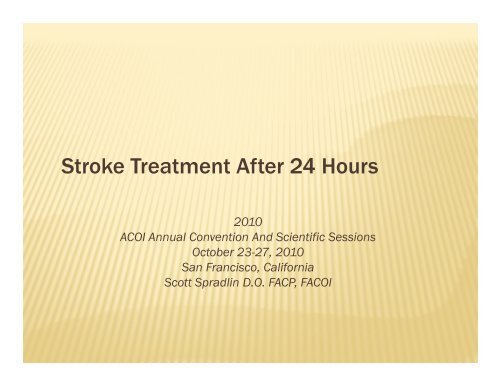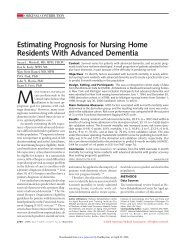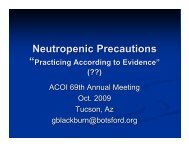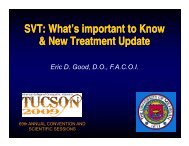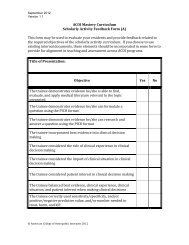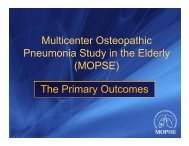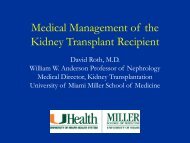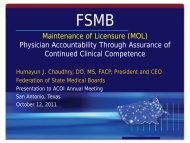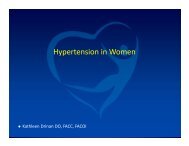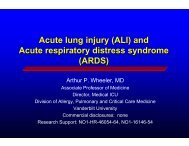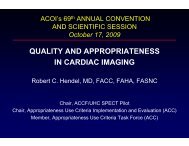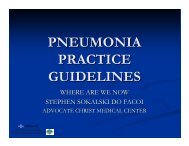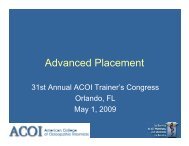Stroke Treatment After 24 Hours
Stroke Treatment After 24 Hours
Stroke Treatment After 24 Hours
Create successful ePaper yourself
Turn your PDF publications into a flip-book with our unique Google optimized e-Paper software.
<strong>Stroke</strong> <strong>Treatment</strong> <strong>After</strong> <strong>24</strong> <strong>Hours</strong><br />
2010<br />
ACOI Annual Convention And Scientific Sessions<br />
October 23-27, 2010<br />
San Francisco, California<br />
Scott Spradlin D.O. FACP, FACOI
GENERAL STROKE TREATMENT<br />
Content<br />
Monitoring<br />
Pulmonary and airway care<br />
Fluid balance<br />
Blood pressure<br />
Glucose metabolism<br />
Body temperature
MONITORING<br />
Continuous monitoring<br />
Heart rate<br />
Breathing rate<br />
O 2 saturation<br />
Discontinuous monitoring<br />
Blood pressure<br />
Blood glucose<br />
Vigilance (GCS), pupils<br />
Neurological status (e.g. NIH stroke scale or<br />
Scandinavian i stroke scale)
PULMONARY FUNCTION<br />
Background<br />
Adequate oxygenation is important<br />
Improve blood oxygenation by administration of > 2<br />
liters O 2<br />
Risk for aspiration in patients with side positioning<br />
Hypoventilation may be caused by pathological<br />
respiration pattern<br />
Risk of airway obstruction ti (vomiting, oropharyngeal<br />
muscular hypotonia): mechanical airway protection
BLOOD PRESSURE<br />
Background<br />
Elevated in most patients with acute stroke<br />
BP drops spontaneously during the first days<br />
after stroke<br />
Blood flow in the critical penumbra passively<br />
dependent on the mean arterial pressure<br />
There are no adequately sized randomized,<br />
controlled studies guiding BP management
BLOOD PRESSURE<br />
Specific issues<br />
Elevated BP (e.g. up to 200mmHg systolic or<br />
110mmHg diastolic) may be tolerated in the acute<br />
phase of ischemic stroke without intervention<br />
BP may be lowered if this is required by cardiac<br />
conditions<br />
Upper level of systolic BP in patients undergoing<br />
thrombolytic therapy is 180mmHg<br />
Avoid and treat hypotension<br />
Avoid oddastc drastic reduction educto in BP
GLUCOSE METABOLISM<br />
Background<br />
<br />
High glucose levels in acute stroke may increase the<br />
size of the infarction and reduce functional outcome<br />
Hypoglycemia can mimic acute ischemic infarction<br />
Routine use of glucose potassium insulin (GKI)<br />
infusion i regimes in patients with mild to moderate<br />
hyperglycemia did not improve outcome 1<br />
It is common practice to treat hyperglycemia with insulin when<br />
blood glucose exceeds 180mg/dl 2 (10mmol/l)<br />
1: Gray CS et al.: Lancet Neurol (2007) 6:397-406<br />
2: Langhorne P et al.: Age Ageing (2002) 31:365-71.
BODY TEMPERATURE<br />
Background<br />
<br />
<br />
Fever is associated with poorer neurological outcome<br />
after stroke<br />
Fever increases infarct size in experimental stroke<br />
Many patients with acute stroke develop a febrile<br />
infection<br />
i<br />
There are no adequately sized trials guiding temperature<br />
management after stroke<br />
It is common practice treat fever (and its cause) when the<br />
temperature reaches 37.5°C
GENERAL STROKE TREATMENT<br />
Recommendations (1/4)<br />
• Intermittent monitoring of neurological status, pulse, blood<br />
pressure, temperature and oxygen saturation is<br />
recommended d for 72 hours in patients t with significant<br />
ifi persisting neurological deficits (Class IV, GCP)<br />
• Oxygen should be administered if sPO 2 falls below 95%<br />
(Class IV, GCP)<br />
• Regular monitoring of fluid balance and electrolytes is<br />
recommended d in patients with ihsevere stroke orswallowing<br />
problems (Class IV, GCP)
GENERAL STROKE TREATMENT<br />
Recommendations (2/4)<br />
• Normal saline (0.9%) is recommended for fluid replacement<br />
during the first <strong>24</strong> hours after stroke (Class IV, GCP)<br />
• Routine blood pressure lowering is not recommended<br />
following acute stroke (Class IV, GCP)<br />
• Cautious blood pressure lowering is recommended in<br />
patients with any of the following; extremely high blood<br />
pressures (>220/120 mmHg) on repeated measurements,<br />
or severe cardiac failure, aortic dissection, i or hypertensive<br />
encephalopathy (Class IV, GCP)
GENERAL STROKE TREATMENT<br />
Recommendations (3/4)<br />
• Abrupt blood pressure lowering should be avoided (Class II,<br />
Level C)<br />
• Low blood pressure secondary to hypovolemia or associated<br />
with neurological deterioration in acute stroke should be<br />
treated with volume expanders (Class IV GCP)<br />
• Monitoring serum glucose levels is recommended (Class IV,<br />
GCP)<br />
• <strong>Treatment</strong> of serum glucose levels >180mg/dl (>10mmol/l)<br />
with insulin titration is recommended (Class IV, GCP)
GENERAL STROKE TREATMENT<br />
Recommendations (4/4)<br />
• Severe hypoglycemia (37.5°C) with acetominophen and<br />
fanning is recommended (Class III, Level C)<br />
• Antibiotic prophylaxis is not recommended in<br />
immunocompetent patients (Class II, Level B)
ANTIPLATELET THERAPY<br />
Background<br />
Aspirin was tested in large RCTs in acute (
ANTICOAGULATION<br />
Unfractionated heparin<br />
No formal trial available testing standard i.v. heparin<br />
IST showed no net benefit for s.c. heparin treated<br />
patients because of increased risk of ICH 1<br />
Low molecular weight heparin<br />
No benefit on stroke outcome for low molecular<br />
heparin<br />
Heparinoid (orgaran)<br />
TOAST trial neutral 2<br />
1: International-<strong>Stroke</strong>-Trial: Lancet (1997) 349:1569-1581<br />
2: TOAST Investigators: JAMA (1998) 279:1265-72.
NEUROPROTECTION<br />
No adequately sized trial has yet shown<br />
significant effect in predefined endpoints for<br />
any neuroprotective substance<br />
1: Davalos A et al.: <strong>Stroke</strong> (2002) 33:2850-7
SPECIFIC TREATMENT<br />
Recommendations (4/5)<br />
• Aspirin (160–325 mg loading dose) should be given within<br />
48 hours after ischemic stroke (Class I, Level A)<br />
• If thrombolytic therapy is planned or given, aspirin or other<br />
antithrombotic therapy should not be initiated within <strong>24</strong><br />
hours (Class IV, GCP)<br />
• The use of other antiplatelet agents (single or combined) is<br />
not recommended in the setting of acute ischemic stroke<br />
(Class III, LevelC)<br />
• The administration of glycoprotein-IIb-IIIa inhibitors is not<br />
recommended (Class I, Level A)
SPECIFIC TREATMENT<br />
Recommendations (5/5)<br />
• Early administration of unfractionated heparin, low<br />
molecular weight heparin or heparinoids is not<br />
recommended d for the treatmentt t of patients t with ischemic<br />
i<br />
stroke (Class I, Level A)<br />
• Currently, there is no recommendation to treat ischemic<br />
stroke patients with neuroprotective substances (Class I,<br />
Level A)
ELEVATED INTRACRANIAL PRESSURE<br />
Basic management<br />
Head elevation up to 30°<br />
Pain relief and sedation<br />
Osmotic agents (glycerol, mannitol, hypertonic saline)<br />
Ventilatory support<br />
Barbiturates, hyperventilation<br />
Achieve normothermia<br />
Hypothermia may reduce mortality 1<br />
1: Steiner T et al.: Neurology (2001) 57(Suppl 2):S61-8.
ELEVATED INTRACRANIAL PRESSURE<br />
Malignant MCA/hemispheric infarction<br />
Pooled analysis of three European RCTs (N=93) 1,2 :<br />
Significantly decreases mortality after 30 days<br />
Significantly more patients with mRS
ELEVATED INTRACRANIAL PRESSURE<br />
Absolute risk reduction (ARR) and odds ratio (OR) for unfavorable outcome at<br />
12 months: combined analysis of decompression trials 1<br />
1: Vahedi K et al.: Lancet Neurol (2007) 6:215-22
ELEVATED INTRACRANIAL PRESSURE<br />
Recommendations (1/2)<br />
• Surgical decompressive therapy within 48 hours after<br />
symptom onset is recommended in patients up to 60 years<br />
of age with evolving li malignant MCA infarcts (Class I, LevelA)<br />
• Osmotherapy can be used to treat elevated intracranial<br />
pressure prior to surgery if this is considered (Class III, Level<br />
C)
ELEVATED INTRACRANIAL PRESSURE<br />
Recommendations (2/2)<br />
• No recommendation can be given regarding hypothermic<br />
therapy in patients with space-occupying infarctions (Class<br />
IV, GCP)<br />
• Ventriculostomy or surgical decompression can be<br />
considered for treatment of large cerebellar infarctions that<br />
compress the brainstem (Class III, Level C)
MANAGEMENT OF COMPLICATIONS<br />
Aspiration and pneumonia<br />
Bacterial pneumonia is one of the most<br />
important complications in stroke patients 1<br />
Preventive strategies<br />
Withhold oral feeding until demonstration of intact swallowing,<br />
preferable using a standardized test<br />
Nasogastric (NG) or percutaneous enteral gastrostomy (PEG)<br />
Frequent changes of the patient’s position in bed and pulmonary<br />
physical therapy<br />
Prophylactic administration of levofloxacin is not<br />
superior to optimal care 2<br />
1: Weimar C et al.: Eur Neurol (2002) 48:133-40<br />
2: Chamorro A et al.: <strong>Stroke</strong> (2005) 36:1495-500
MANAGEMENT OF COMPLICATIONS<br />
Urinary tract infections<br />
Most hospital-acquired urinary tract infections are<br />
associated with the use of indwelling catheters 1<br />
Intermittent catheterization does not reduce the risk<br />
of infection<br />
If urinary infection is diagnosed, appropriate<br />
antibiotics should be chosen following basic medical<br />
principles<br />
1: Gerberding JL: Ann Intern Med (2002) 137:665-70c
MANAGEMENT OF COMPLICATIONS<br />
Deep vein thrombosis and pulmonary embolism<br />
Risk might be reduced by good hydration and early<br />
mobilization<br />
Low-dose LMWH reduces the incidence of both DVT<br />
(OR 0.34) and pulmonary embolism (OR 0.36),<br />
without a significantly increased risk of intracerebral<br />
(OR 1.39) or extracerebral haemorrhage (OR 1.44) 1,2<br />
1: Diener HC et al.: <strong>Stroke</strong> (2006) 37:139-44<br />
2: Sherman DG et al.: Lancet (2007) 369:1347-55
MANAGEMENT OF COMPLICATIONS<br />
Pressure ulcer<br />
Use of support surfaces, frequent repositioning,<br />
optimizing nutritional status, and moisturizing sacral<br />
skin are appropriate preventive strategies<br />
1<br />
Seizures<br />
Prophylactic anticonvulsive treatment is not<br />
beneficial<br />
Agitation<br />
Causal treatment must precede any type of sedation<br />
or antipsychotic treatment<br />
1: Reddy M et al.: JAMA (2006) 296:974-84
MANAGEMENT OF COMPLICATIONS<br />
Falls<br />
Are common in every stage of stroke treatment<br />
Risk factors include cognitive impairment,<br />
depression, polypharmacy and sensory impairment 1<br />
A multidisciplinary package focusing on personal and<br />
environmental factors might be preventive 2<br />
Exercise, calcium supplements and bisphosphonates<br />
improve bone strength and decrease fracture rates in<br />
stroke patients 3,4<br />
1: Aizen E et al.: Arch Gerontol Geriatr (2007) 44:1-12<br />
2: Oliver D et al.: BMJ (2007) 334:82<br />
3: Pang MY et al.: Clin Rehabil (2006) 20:97-111<br />
4: Sato Y et al.: Cerebrovasc Dis (2005) 20:187-92
MANAGEMENT OF COMPLICATIONS<br />
Dysphagia and feeding<br />
Dysphagia occurs in up to 50% of patients with<br />
unilateral hemiplegic stroke and is an<br />
independent d risk-factor kf for poor outcome 1<br />
For patients with continuing dysphagia, options<br />
for enteral nutrition include NG or PEG feeding<br />
PEG does not provide better nutritional status or<br />
improved clinical outcome, compared to NG 2,3<br />
1: Martino R et al.: <strong>Stroke</strong> (2005) 36:2756-63<br />
2: Dennis MS et al.: Lancet (2005) 365:764-72<br />
3: Callahan CM et al.: J Am Geriatr Soc (2000) 48:1048-54
MANAGEMENT OF COMPLICATIONS<br />
Recommendations (1/4)<br />
• Infections after stroke should be treated with appropriate<br />
antibiotics (Class IV, GCP)<br />
• Prophylactic administration of antibiotics is not<br />
recommended, and levofloxacin can be detrimental in acute<br />
stroke patients (Class II, Level B)<br />
• Early rehydration and graded compression stockings are<br />
recommended to reduce the incidence of venous<br />
thromboembolism b (Class IV, GCP)<br />
• Early mobilization is recommended to prevent complications<br />
such as aspiration pneumonia, DVT and pressure ulcers<br />
(Class IV, GCP)
MANAGEMENT OF COMPLICATIONS<br />
Recommendations (2/4)<br />
• Low-dose s.c. heparin or low molecular weight heparins<br />
should be considered for patients at high risk of DVT or<br />
pulmonary embolism (Class I, LevelA)<br />
• Administration of anticonvulsants is recommended to<br />
prevent recurrent seizures (Class I, Level A)<br />
• Prophylactic administration of anticonvulsants to patients<br />
with recent stroke who have not had seizures is not<br />
recommended d(Class IV, GCP)<br />
• An assessment of falls risk is recommended for every stroke<br />
patient (Class IV, GCP)
MANAGEMENT OF COMPLICATIONS<br />
Recommendations (3/4)<br />
• Calcium/vitamin-D supplements are recommended in stroke<br />
patients at risk of falls (Class II, Level B)<br />
• Bisphosphonates (alendronate, etidronate and risedronate)<br />
are recommended in women with previous fractures (Class<br />
II, Level B)<br />
• In stroke patients with urinary incontinence, specialist<br />
assessment and management is recommended (Class III,<br />
LevelC)<br />
• Swallowing assessment is recommended but there are<br />
insufficient data to recommend a specific approach for<br />
treatment (Class III, GCP)
MANAGEMENT OF COMPLICATIONS<br />
Recommendations (4/4)<br />
• Oral dietary supplements are only recommended for nondysphagic<br />
stroke patients who are malnourished (Class II,<br />
LevelB)<br />
• Early commencement of nasogastric (NG) feeding (within 48<br />
hours) is recommended in stroke patients with impaired<br />
swallowing (Class II, Level B)<br />
• Percutaneous enteral gastrostomy (PEG) feeding should not<br />
be considered d in stroke patients in the first 2 weeks (Class II,<br />
Level B)
REHABILITATION<br />
Early rehabilitation<br />
More than 40 % of stroke patients need active<br />
rehabilitation<br />
Active rehabilitation should start early, providing<br />
the patient is clinically stable<br />
Passive rehabilitation should be given if the<br />
patient is unconscious or paralyzed<br />
Rehabilitation should be continued as long as<br />
perceptable recovery is taking place
REHABILITATION<br />
Multidisciplinary stroke team for rehabilitation<br />
<strong>Stroke</strong> physician<br />
Nurses experienced in stroke management<br />
Physiotherapist trained in stroke rehabilitation<br />
Occupational therapist skilled in stroke<br />
Speech therapist familiar with speech problems in<br />
stroke patients<br />
Neuropsychologist accustomed to stroke<br />
rehabilitation<br />
Social worker familiar with the problems of stroke<br />
patients
SETTING OF REHABILITATION<br />
Recommendations (1/2)<br />
• Admission to a stroke unit is recommended for acute stroke<br />
patients to receive coordinated multidisciplinary<br />
rehabilitation ti (Class I, LevelA)<br />
• Early discharge from stroke unit care is possible in medically<br />
stable patients with mild or moderate impairment providing<br />
that rehabilitation is delivered in the community by a<br />
multidisciplinary team with stroke expertise (Class I, Level A)
SETTING OF REHABILITATION<br />
Recommendations (2/2)<br />
• Rehabilitation should be continued after discharge during<br />
the first year after stroke (Class II, Level A)<br />
• Early initiation of rehabilitation is recommended (Class III,<br />
Level C)<br />
• It is recommended that the duration and intensity of<br />
rehabilitation is increased (Class II, Level B)
ELEMENTS OF REHABILITATION<br />
Recommendations (1/3)<br />
• Physiotherapy is recommended, but the optimal mode of<br />
delivery is unclear (Class I, Level A)<br />
• Occupational therapy is recommended, but the optimal<br />
mode of delivery is unclear (Class I, Level A)<br />
• While assessment for communication deficits is<br />
recommended, there are insufficient data to recommend<br />
specific treatments (Class III, GCP)<br />
• Information should be provided to patient and carers but<br />
evidence does not support use of a dedicated stroke liaison<br />
service for all patients (Class II, Level B)
ELEMENTS OF REHABILITATION<br />
Recommendations (2/3)<br />
• Rehabilitation must be considered for all stroke patients, but<br />
there is limited evidence to guide appropriate treatment for<br />
themostt severely disabled d (Class II, LevelB)<br />
• While assessment for cognitive deficits appears desirable,<br />
there are insufficient data to recommend specific<br />
treatments (Class I, Level A)<br />
• Patients should be monitored for depression during hospital<br />
stay and throughout h fll follow up (Class IV, LevelB)
ELEMENTS OF REHABILITATION<br />
Recommendations (3/3)<br />
• Drug therapy and non-drug interventions are recommended<br />
to improve mood (Class I, Level A)<br />
• Drug therapy should be considered to treat post stroke<br />
emotionalism (Class II, Level B)<br />
• Tricyclic or anticonvulsant therapy are recommended to treat<br />
post-stroke neuropathic pain in selected patients (Class III,<br />
Level B)<br />
• Botulinum toxin should be considered to treat post-stroke<br />
spasticity, but functional benefits are uncertain (Class III,<br />
Level B)


